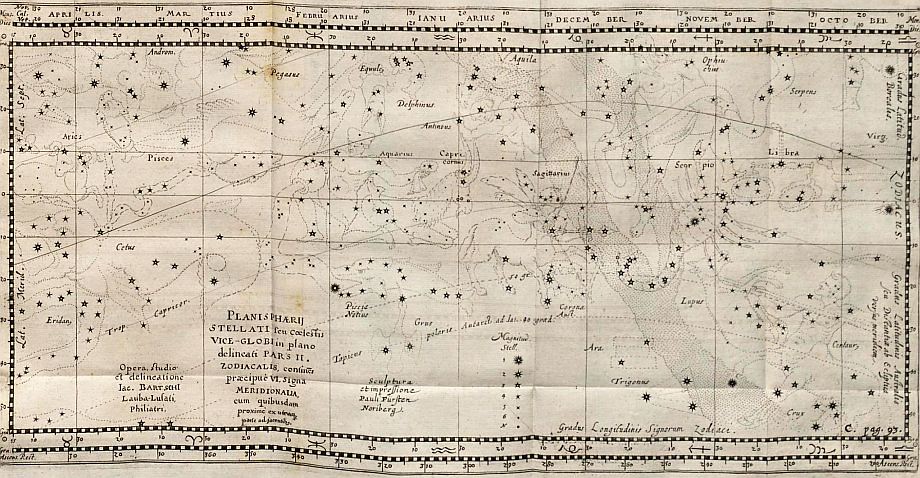
|
|
Star Lore ArtThe Star Maps of |
|


In 1612, Dutch-Flemish astronomer and cartographer Petrus Plancius designed eight new constellations in the northern
hemisphere and along the celestial equator. Six of them were shown on two maps in 1624 and 1628.
 In 1922, when the IAU adopted its 88 official constellations only two of these six creations (Camelopardalis and Monoceros) made the cut, but all of them have their historical significance. |


 Apes  Bees |

 Camelopardalis  Giraffe |

 Gallus  Rooster |

 Jordanis  River Jordan |

 Monoceros  Unicorn |

 Tigris  Tigris River |

Plancius' constellations were first introduced in 1613 on a celestial globe published by
Pieter van den Keere and then in 1621 on a globe by
Isaac Habrecht II. But As long as the constellations only appeared on
globes, there did not receive much public recognition.
 In 1624, German astronomer Jakob Bartsch (son-in-law of famous Johannes Kepler) was the first to put the new constellations on maps in his book Usus Astronomicus Planisphaerii Stellati (Astronomical Use of the Stellar Planisphere).  The book contained a north polar planisphere (right) showing stars of the northern hemisphere down to 35° north and and two equatorial charts (below) covering the stars between declinations of 35° north and 53° south.  In 1624, Isaac Habrecht II, the manufacturer of the 1621 globe published his own star charts. His book Planiglobium coeleste et terrestre contained two planispheres of the northern and southern celestial hemispheres.  In his maps, Habrecht included a constellation of his own design, the Rhombus, a constellation that later morphed into Reticulum.  Source: Ian Ridpath |
 Bartsch, Polar Planisphere
Bartsch, Polar PlanisphereSources: SLUB Digitale Sammlungen, Ian Ridpath: Star Tales |

The maps of Bartsch and Habrecht were not as colorful as the planispheres of Dürer and Apianus, but
they deserve their place in this collection as they, in the words of Ian Ridpath "... introduced six
new constellations ... to a wider audience, much as Johann Bayer’s Uranometria had done for the
12 southern constellations of Keyser and de Houtman two decades earlier.
|
|
| 
 Rhombus |

 Bartsch First Equatorial Chart; source: SLUB Digitale Sammlungen
Bartsch First Equatorial Chart; source: SLUB Digitale Sammlungen |

 Bartsch First Equatorial Chart; source: SLUB Digitale Sammlungen
Bartsch First Equatorial Chart; source: SLUB Digitale Sammlungen |

 Habrecht, Northern Hemisphere; Source: ECHO – Cultural Heritage Online
Habrecht, Northern Hemisphere; Source: ECHO – Cultural Heritage Online |
 Habrecht, Northern Hemisphere; Source: ECHO – Cultural Heritage Online
Habrecht, Northern Hemisphere; Source: ECHO – Cultural Heritage Online |


|
Back to Star Lore |
Back to Art |
Back to Space Page |
Back to English |
 Back to Start Page |